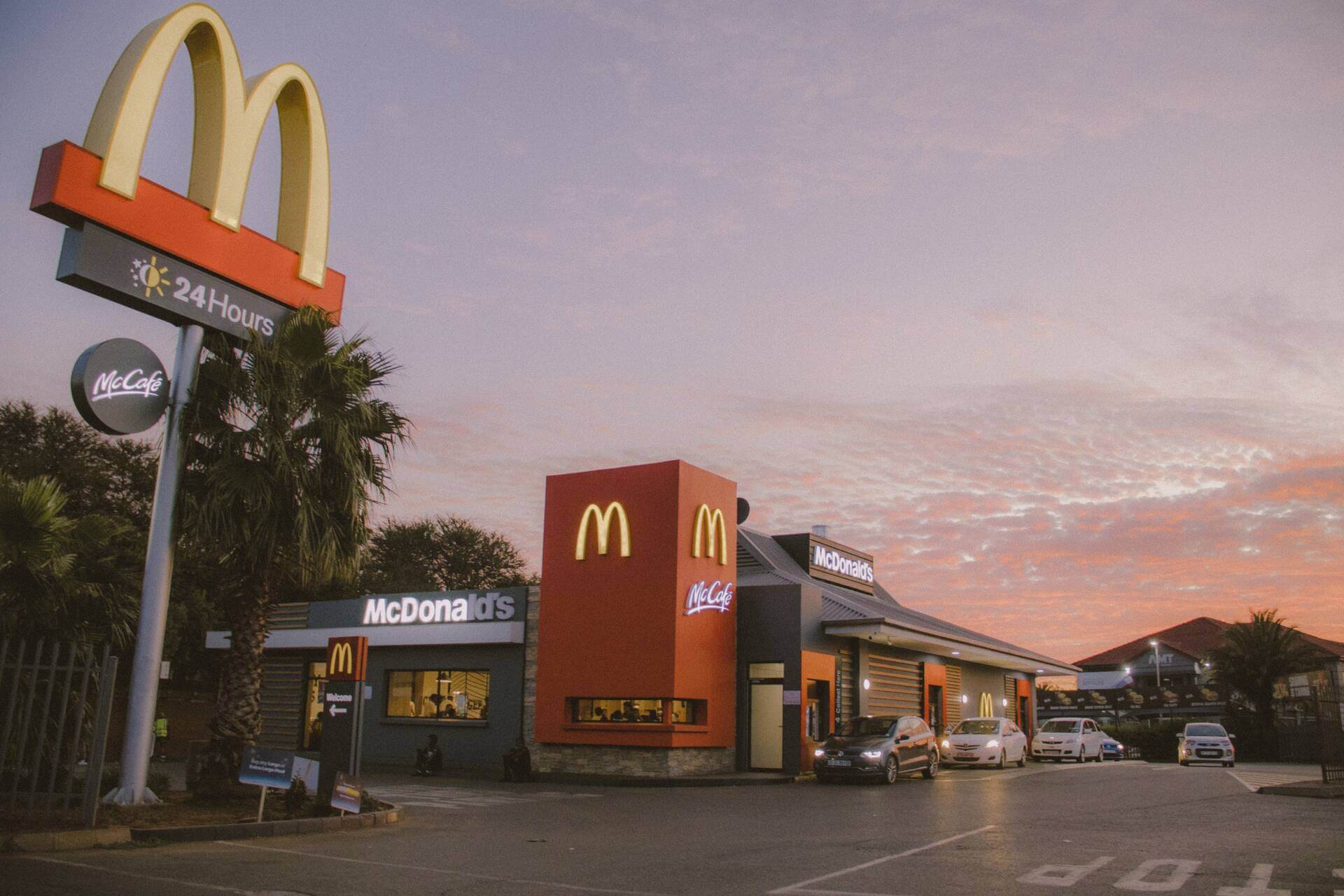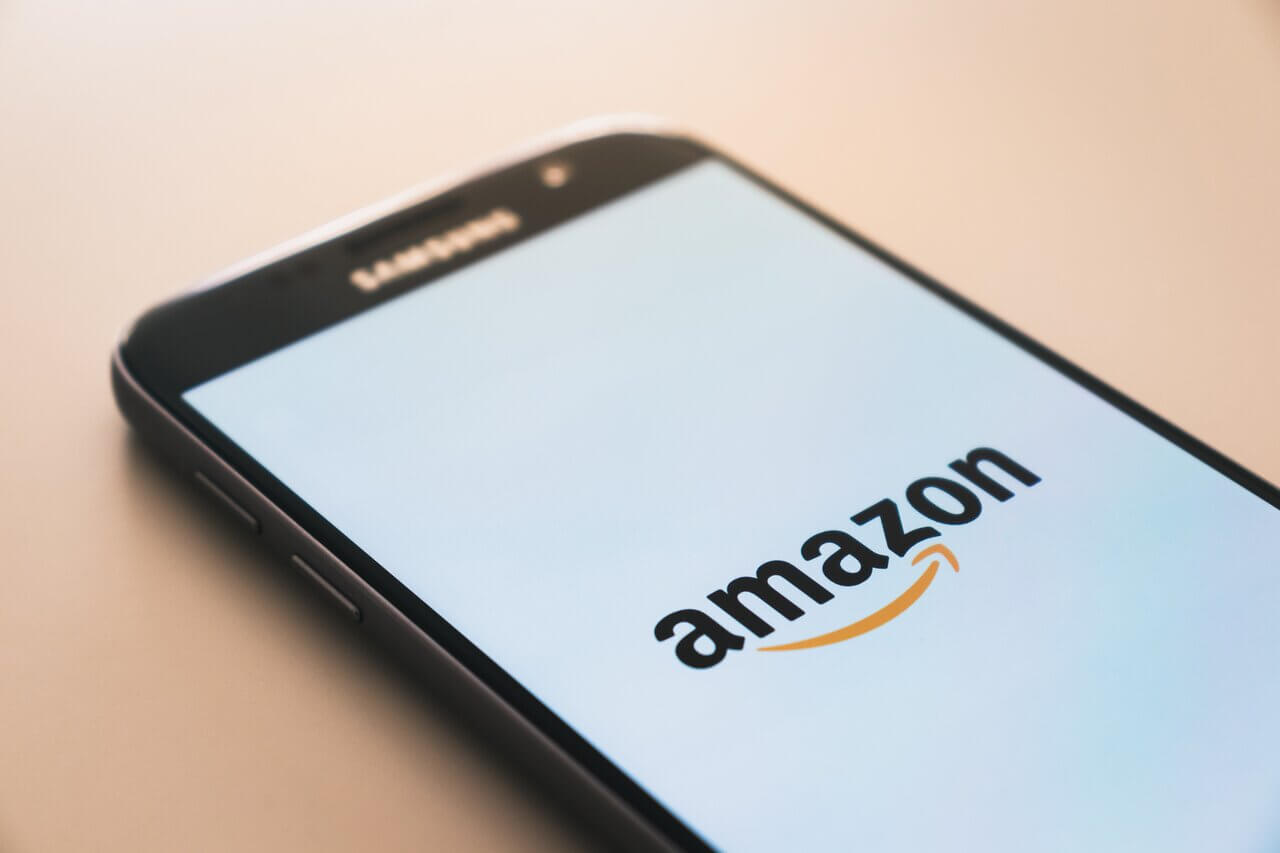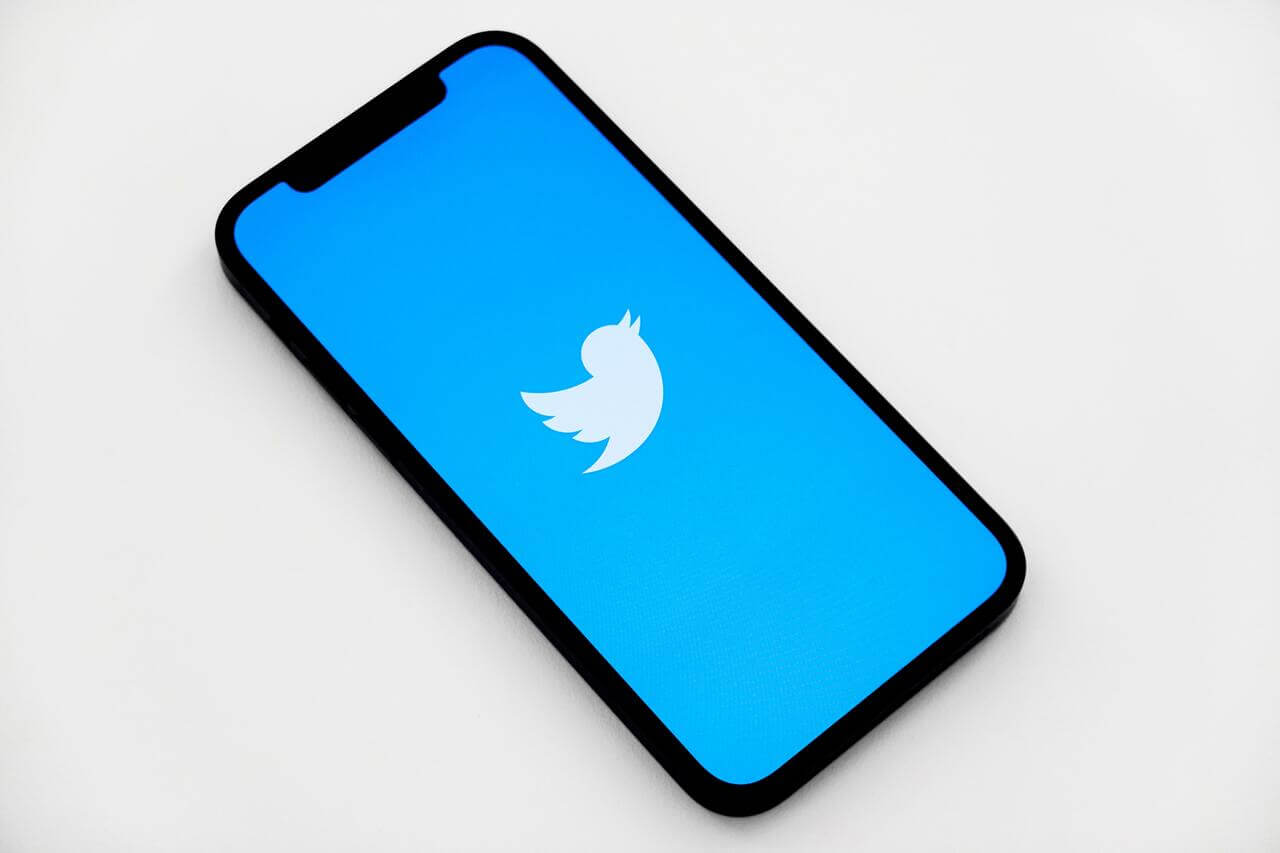IKEA is one of the world’s largest furniture retail companies today. In 2020, IKEA was the seventh most valuable retailer brand worldwide. It was valued at nearly $19 billion and operated over 400 stores in multiple countries, generating more than $35 billion. The Swedish multinational group designs affordable, high-quality ready-to-assemble furniture, kitchen appliances, and other home products.
Since 2008 it has dominated the retail furniture market. Despite the popularity of online shopping, IKEA still draws millions of shoppers to its physical stores. In fact, in 2020, IKEA stores had 825 million visits globally despite the raging Covid-19 pandemic. The previous year they were sitting at 1 billion store visits.
It’s clear that IKEA is a formidable giant, but how does the company do it? How have they consistently offered high-quality, innovative furniture products at an affordable price for nearly eight decades? How do they still manage to draw in millions of customers to their stores?
If you’ve ever shopped at IKEA, you’ve probably been a victim of the IKEA pull. Time seems to stop the moment you pass through the doors. Instead of just getting the furniture piece you went looking for, you end up going home with two new kitchen appliances and some Swedish meatballs. This effect is by design.
The success of IKEA’s business model can be attributed to many things; the “IKEA Effect’ is one of them. However, the most crucial factor to IKEA’s success is its iron grip on cost control during product development. As one of the world’s largest privately-held companies, its financial success can also be attributed to the frugal character of its founder Ingvar Kamprad.
So let’s take an in-depth look at how IKEA has managed to grow and sustain this business model without investors.
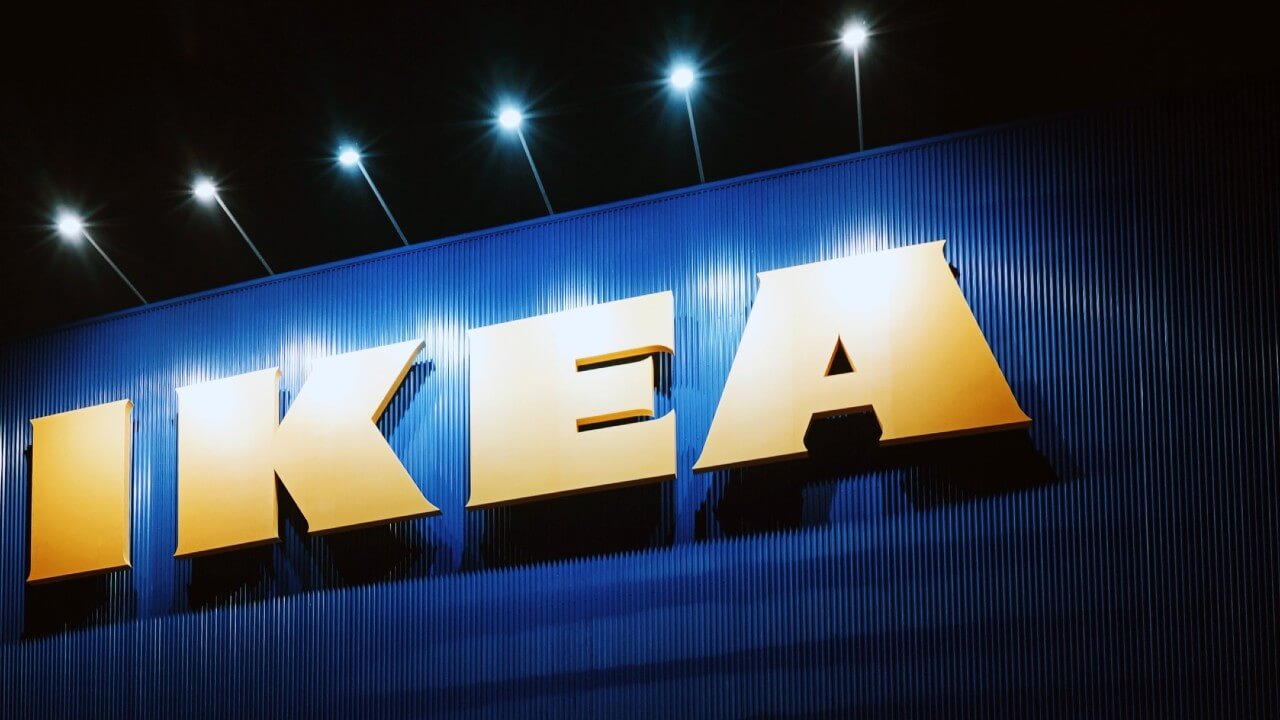
1943-1959: Birth of IKEA
1943: How IKEA Was Born
The story of IKEA begins right before the end of WWII in 1943. Growing up in rural Sweden, Kamprad had started his first business at five years old selling matchbooks. By the time he was 10, he had moved on to selling pens, pencils, and flower seeds.
In 1943, a 17-year-old Ingvar Kamprad was given some money by his father to do well at school. It was a considerable achievement because he had dyslexia and had to work extra hard to pass. Kamprad used his reward money to start a small business selling common household and personal items.
Rural Sweden had access to very little, especially the Swedish province of Småland, where Ingvar lived. The young teenager quickly realized that there was a market for cheaper goods because the war had affected the Swedish and global economy. The average person was looking to save as much as they could.
Kamprad sold pens, wallets, table runners, watches, jewelry, postcards, nylon stockings, and picture frames, all at reduced prices. His distribution channel was his mother’s bicycle, and he would ride it to the various farms to deliver his merchandise.
1945: First Advertisement & a Shift to Mail-orders
His business strategy was a hit, and in 1945, Kamprad could no longer cope with making individual sales calls. So he began advertising in the local newspapers and turned his business into a mail-order service. He partnered with local milk truck drivers who would deliver his products to a nearby train station.
1948-1951: Introduction of IKEA Furniture Catalogue & Competition with Swedish Furniture Cartel
Five years later, Kamprad introduced furniture into the IKEA range of products. WWII had ended, and the world was on a rebuilding spree. Post-war Sweden had young people and families that were looking for stylish and affordable furniture.
Traditionally, the young generation would receive hand-down furniture from their families. Since 1935 the furniture cartel made up of Swedish manufacturers and retailers had an agreement to keep furniture prices high. This caused a price rise 41% higher than any other household products.
With the post-war Swedish government building a lot of housing and dishing out home furnishing loans, Kamprad saw a gap in the market. In the Småland province where he grew up, several small furniture factories used timber from local forests to produce furniture. So, he started placing large orders from the local factories and selling furniture at a reduced price. This did not go down well with the Swedish furniture mafia.
1951: IKEA Launches Its Iconic Furniture Catalogue and Faces Resistance from Swedish Furniture Cartel
Launch of Furniture Catalogue & First Display Store
IKEA launched its first official catalog featuring the MK wing chair on the cover. The launch was met with criticism from the public. The prices were so low compared to the average in the country. Many people were skeptical about the furniture quality, believing it would be poorly constructed. There was also an issue of items being returned because customers were expecting something different from what they had ordered.
Kamprad always saw challenges as a way to improve his business. So instead of being discouraged by the lukewarm response, he found a way to work around the problem. He opened the first IKEA display store in an old rented workshop to give customers a chance to see what they were purchasing. This drastically reduced the number of items that customers returned.
IKEA vs. Swedish Furniture Cartel
When IKEA entered the furniture market in Sweden, it was a significant threat to the existing furniture companies. When IKEA took part in its first annual furniture trade fair, the cartel forbade them from selling directly to customers. They banned IKEA from displaying their prices during the show.
Eventually, the cartel took it a step further and pressured factories to stop selling to IKEA. This cut off the company’s source of supplies in Sweden. Retailers were no longer buying from manufacturers that sold to IKEA. Because the cartel had a strong influence in the industry, most manufacturers were too afraid to defy it.
This ban posed a big problem for IKEA because the boycott would lead to bankruptcy. The political climate at that time made it unpopular to do business with communist countries. However, IKEA took the plunge and set its sights on Poland’s suppliers.
It turned out to be a brilliant move because Poland suppliers had lower prices than the Swedes, even with the added transportation costs. IKEA managed to charge even less than they had been doing before. This combination of low prices was hard to compete against. IKEA began establishing itself as a significant competitor in the Swedish furniture market.
IKEA’s Business Model Canvas: The Early Days
At this point, IKEA’s Business Model Canvas looked like this:
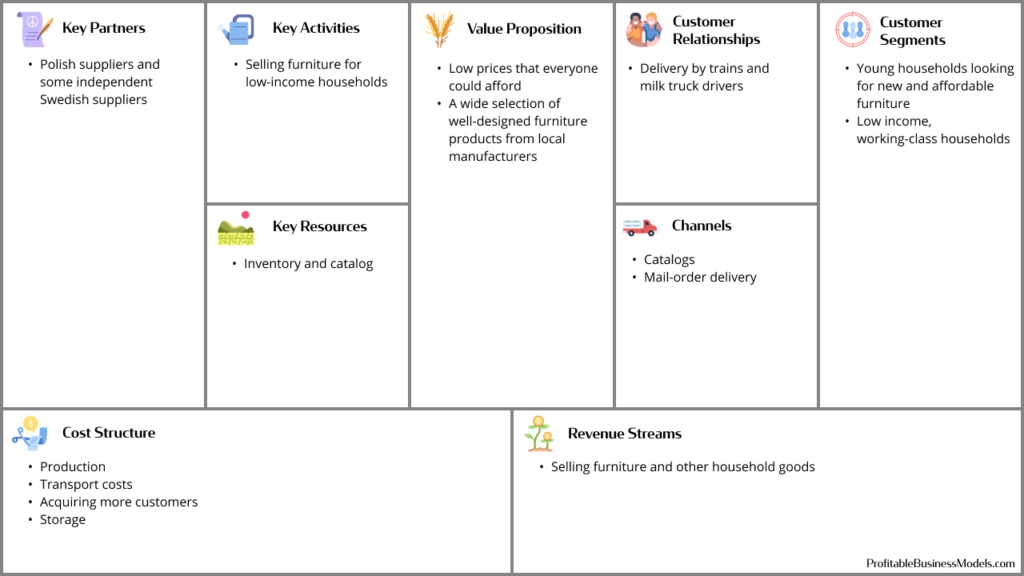
1953-1959: Establishing The First Showroom & The Adoption of Flat-packing
1953: The First Showroom Opens & the Birth of IKEA In-store Restaurants
Initially, the display store solved the skepticism that IKEA faced when it began selling furniture. However, the bulk of its products were being sold by mail. Unfortunately, the mail-order business in Sweden was facing significant PR challenges.
Due to the stiff competition in the industry, prices were being driven down. The furniture cartel decided to compromise quality to increase their profit margins. This led to a very negative public image that affected the whole industry.
Kamprad and Sven Göte (one of IKEA’s early competitors) worked on a concept for a permanent showroom to solve the problem. And just like the first display store, its purpose was to allow the customer to see the products before they purchased them via mail.
They opened a permanent showroom in Älmhult. The city was very remote, and Kamprad was worried that people would be reluctant to travel that far just to view furniture. He decided to offer customers coffee and buns as an incentive, and that’s how the idea for an IKEA in-store restaurant was born. The idea worked well for the company.
1956: IKEA Adopts Flat-packing & Launch Of the “IKEA Effect.”
In 1955, IKEA’s deal with its suppliers began to sour. The manufacturers wanted to increase their prices which would affect IKEA. Kamprad did not want to raise the price of his furniture and instead decided to bring manufacturing and design in-house. So now IKEA was designing, manufacturing, showcasing, and selling its furniture.
This move proved to be the right one for IKEA because now the company had complete control over its entire process. It helped the company to develop unique Scandinavian designs that made the IKEA brand distinct.
Hello Flat-packing!
But there was still the issue of mail-order delivery that was causing problems. Delivering assembled furniture via mail-order had a higher risk of damage upon arrival. It was also expensive. Due to IKEA’s desire to focus on giving its customer’s the most affordable prices, Kamprad looked for a solution.
Flat-packing already existed elsewhere in the world, but it was not popular in Sweden. An employee came up with the idea to adopt flat-packing for IKEA products. The concept takes off at IKEA after Ovendals, one of their suppliers, demonstrates how flat-packing works on a table.
The solution allowed IKEA to keep its prices low. Still, the customer had to be willing to assemble their own furniture for the idea to work. This concept was virtually unheard of in Sweden, but Kamprad was not deterred. He adopts flat-packing for most of IKEA’s products and manages to keep prices low. Fortunately, IKEA receives a positive response from its customers.
He didn’t know it then, but Kamprad had essentially birthed the “IKEA Effect.” This effect describes the way customers place an inordinately high value on products they feel they had a part in creating.
IKEA continued to work on creating unique designs, such as the HANSA bookcase in 1957. They also employed special consultants that sketched how new IKEA furniture would look in customer’s living rooms using graph paper. All these innovative and cost-reduction strategies catapulted IKEA’s success. By the end of the 1950s, Kamprad was ready to expand outside Sweden.
1960 – 1989: Global Expansion & Product Diversification
1960: The First IKEA Restaurant Opens
“It’s difficult to do business with someone on an empty stomach.”
Ingvar Kamprad
Until the beginning of 1960, IKEA offered coffee and cold snacks to its customers and visitors. However, by the end of the year, the IKEA restaurant was officially launched. It had a fully equipped kitchen that included the newly invented microwave oven. The diverse menu served everything from hamburgers and hot dogs to fine dining.
The idea for a full-service in-store restaurant came about after Kamprad noticed that customers left the store during lunchtime to eat at one of the restaurants or food stores in the city. This interrupted the purchasing process, and he firmly believed that hungry people had less patience to browse through the store, meaning they bought fewer items than what Kamprad desired.
1963-1969: International Expansion
In 1963 IKEA expanded outside of Sweden when they opened their first store in Norway. This expansion was followed by a new store in Denmark in 1969.
Meanwhile, back in 1965, IKEA opened its flagship store just outside of Stockholm. At that time, it was the largest furniture store in Northern Europe. The Guggenheim Museum inspired the circular design of the store in New York. Kamprad strategically chose the store’s location because it was easy to reach by car or public transport and had ample parking space.
1970-1979: A Fire Kickstarts IKEA Self-service & Store Standardization
An electrical fault at the IKEA flagship store causes the sign on the roof to catch fire. The damage was substantial and halted normal operations for several months. But true to IKEA’s modus operandi, they used this challenge to develop an innovative way to keep serving their customers.
The company came up with the idea for a self-service area which turned out to be a success. Most of their products became available for pick-up at the self-service area when they reopened in 1971.
IKEA opened its first store in Switzerland in 1973 and another one in Germany in 1974. Up until 1974, when IKEA was expanding, there was no standardization of the stores. IKEA realized that to control the quality of service their customers received worldwide, all IKEA stores needed to look and operate the same way. The company set up specific requirements for each of its stores.
This was the birth of the IKEA pull. The layout for each store was specifically designed to draw the customer in to explore the whole store before making a purchase. The store included Småland, an in-store playground that catered for children.
IKEA continues its expansion around the world. In 1976 the company opened a shop in Vancouver, Canada. In 1977 it arrived in Vienna, Austria, and 1979 in Rotterdam, Netherlands. They also debuted their iconic Swedish meatballs and BILLY bookcase in 1979.
1980-1989 – A New Sustainable Owner Structure
Kamprad wanted to maintain IKEA as a privately held company. His frugality also meant that he despised paying taxes. This led to him closing down the Switzerland store in 1976 to avoid paying hefty taxes.
He also wanted to avoid the headaches that came with trading publicly, such as; paying out dividends and answering to shareholders. The solution was to separate the ownership of IKEA’s retail operations from the brand under a franchise system.
1982: IKEA Group Is Formed
The IKEA Group was formed under the ownership of the Stichting INGKA Charity Foundation based in the Netherlands. The IKEA retail outlets, distribution, and warehousing divisions and companies were controlled by the holding company INGKA Holding, which the foundation owned.
This complicated structure would save IKEA billions of dollars in taxes allowing the company to sustain its business model. It also allowed the company to stay private, minimizing the risk of a hostile takeover from competitors. So essentially, IKEA began operating as a nonprofit corporation from 1982 onwards. A position that contributed to a lot of controversy as the years rolled by.
1984-1989: IKEA FAMILY Customer Club & More Expansion
In 1984 IKEA launched the IKEA FAMILY customer club that gave loyalty discounts to club members. That same year IKEA opened a store in Brussels, Belgium. By the end of 1984, the company had printed 45 million copies of the IKEA catalog in 9 languages.
1985: Lukewarm Launch in America
In January 1985, IKEA arrived in the United States and opened a shop in Philadelphia. The launch was just shy of becoming a complete disaster. IKEA measured all their products in centimeters; this resulted in much confusion about sizes to the American customers. Their biggest mistake was not conducting enough market research before launch. Luckily they managed to correct this mistake a few years later before the store went bankrupt.
The following year, in 1986, Ingvar Kamprad retired from Group Management and became an advisor to INGKA Holdings. In 1987 IKEA expanded into the UK and Italy 1989. By the end of the ’80s, IKEA was no longer a product; it had become an experience.
IKEA’s Business Model Canvas: International Expansion
At this point, IKEA’s Business Model Canvas looked like this:
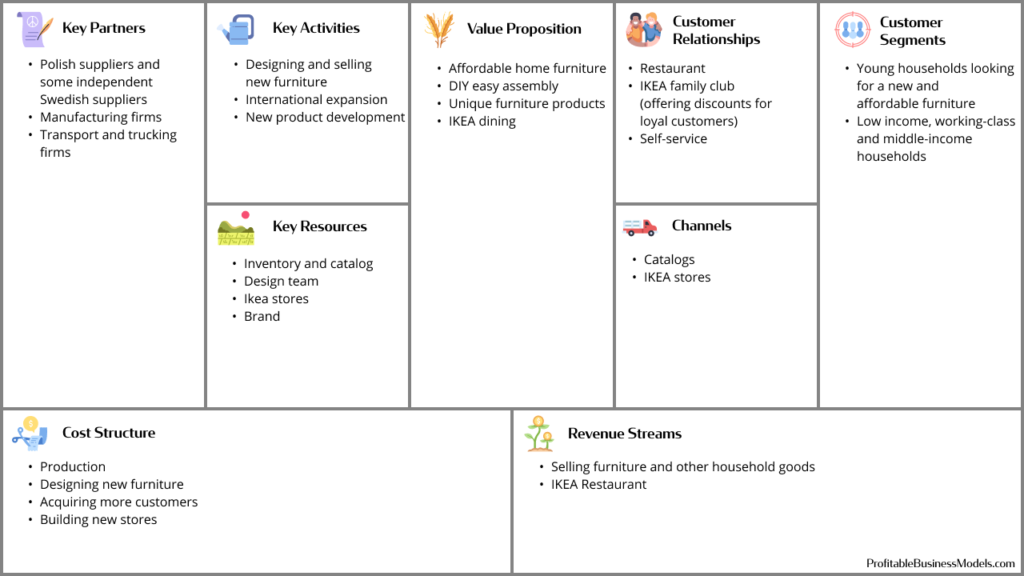
1990-2010: Key Acquisitions, Environmental Policies, and Entry Into the Digital World
In 1990, IKEA developed its first environmental policy to ensure that its employees would take responsibility for their environmental obligations in all business activities. Although this initiative was a good start, IKEA would later face anti-sustainability allegations over its massive use of wood and contribution to deforestation.
1991-1996: IKEA Establishes The Industrial Group Swedwood & Continues To Grow
In 1991, IKEA made a move to control its manufacturing process further. It acquired sawmills and production plants and brought all of them under an industrial group called Swedwood. This department aimed to produce low-cost and environmentally friendly wood furniture. That same year, in a full-circle moment, IKEA arrived in Poland and the Czech Republic.
By the end of 1994, IKEA had raked in $4.5 billion in sales revenue. It had 98 IKEA stores in 17 countries, and 72 million copies of the IKEA catalog had been printed in 34 languages. IKEA had also managed to grow its suppliers to 2 300, and these key partners spanned across 70 countries.
1997: A Children’s Furniture Range & IKEA.com Is Launched
IKEA jumped onto the internet craze and launched what was to become one of their key resources in the 20th century; their IKEA.com website. However, they didn’t start selling online until 2000, beginning in Sweden and Denmark.
IKEA also launched an entire children’s furniture range to cater specifically to kids.
2001: IKEA Launches a Rail Transport Company
To find sustainable ways of transporting their goods through Europe, IKEA formed the IKEA Rail AB Company. The first agreement was for the transportation of IKEA goods between Sweden and Germany. The train ran five round trips a week between Älmhult, in Sweden and Duisburg, in Germany. IKEA ran the rail operation until 2004 when they relinquished operational control to an external company. However, IKEA continued to use this route.
2006: IKEA Food
IKEA had long started carrying food products from other brands in its shops. However, in a bid to expand its products, the company launched IKEA Food in 2006. The label made up at least 30 percent of the 150 food products that the company sold at that time. Most of the products were the high-quality Swedish recipes that IKEA customers loved.
2008: IKEA Enters the Gaming & Mobile Network World
Electronic Arts (EA) entered into a partnership with IKEA to develop furniture for the virtual reality game. The Sims 2 game was launched in 2008 in the US and Europe with iconic IKEA furniture.
IKEA also dipped its toes in the tech world by creating IKEA GreenTech. This €50 million venture capital fund would invest in at least ten companies whose focus was on sustainable technology.
That same year IKEA launched a wireless communications service in the UK called IKEA Family Mobile. It was a communication hosted by T-Mobile and had the lowest pay-as-you-go network prices in the country.
IKEA’s Business Model Canvas: Acquisitions & Product Diversification
At this point, IKEA’s Business Model Canvas looked like this:
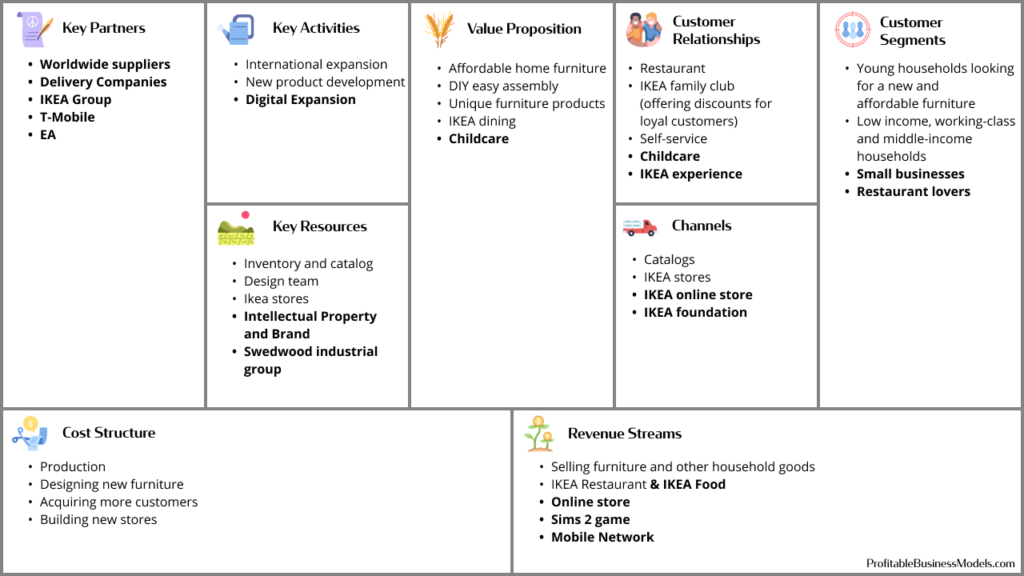
2011-Present: Investments, Acquisitions, Some Lawsuits & the Gig Economy
2012: The IKEA UPPLEVA TV – A Complete Failure
In 2012, IKEA launched the UPPLEVA TV. It was an all-in-one entertainment system that had an HDTV and Blu-ray player. The design and sound were decent enough, but those were the only good things about it.
The TV’s picture quality was terrible, and although it had an internet connection, it was insanely slow. Some buttons were completely unresponsive, and for $1 000, it was not worth the price. IKEA quickly phased out the TV.
2013: Ingvar Kamprad Resigns
In June 2013, Ingvar Kamprad resigned from the board of Inter IKEA Holding SA.
2016: IKEA Recalls All Malm Dressers
In June 2016, a toddler died in the US from an IKEA Malm dresser that collapsed on top of them. This was the third child to die from the same accident. IKEA recalled all Malm dressers and similar models prone to tipping if not secured to the wall with the supplied kit.
The recall extended to China and Europe a month later. By the end of the year, a total of 29 million dressers had been recalled. IKEA was forced to pay over $50 million to the families of the deceased children. This was a substantial financial blow to IKEA.
2017: Launch of IKEA App “IKEA Place” & Some Strategic Acquisitions
In September 2017, IKEA announced the release of the augmented reality app, IKEA Place. The app was meant to compete with Apple’s ARkit technology and iOS 11. IKEA Place helps customers to visualize IKEA products in the virtual world. It was an improvement of the 1950s graph paper sketches.
IKEA also acquired TaskRabbit in a bid to provide its customers with assembly services. IKEA clients could now look on the app for someone to assemble their furniture for them. This was a move away from the idea that customers enjoyed assembling their own furniture. IKEA had realized that the market was changing, and people wanted convenience over spending hours trying to put together furniture.
IKEA’s Business Model Canvas: Adaptation to the Gig Economy & Online Shopping
At this point, IKEA’s Business Model Canvas looked like this:
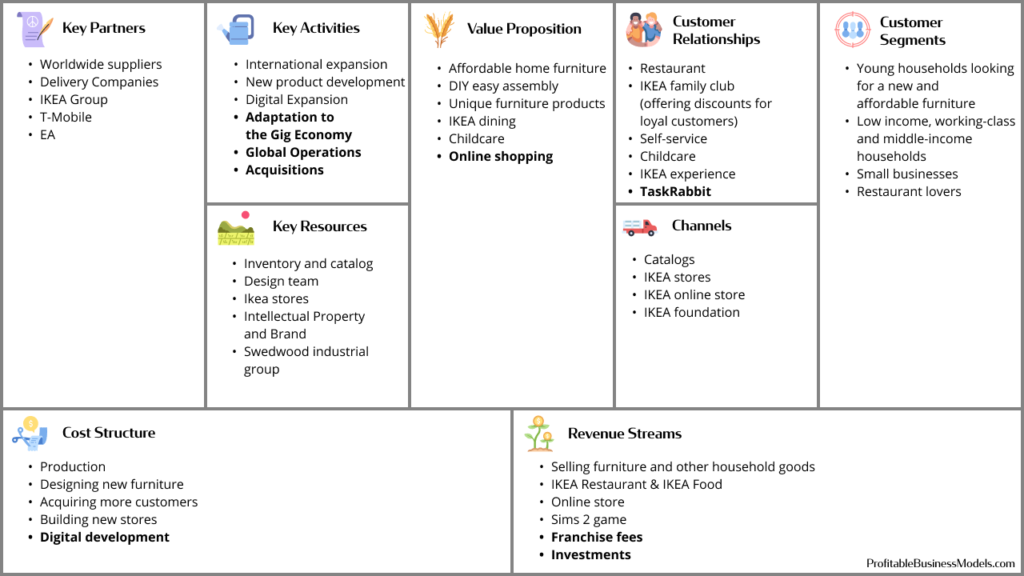
The bottom line
IKEA can offer more than 9,000 products at low prices because of the foundations set by Kamprad when the company began. The complex organizational structure helps sustain the company’s profits despite the ups and downs of the economy.
They enjoy the flexibility and adaptability that most privately-held companies have. The use of global product sourcing, innovative cost-saving ideas, and unique furniture designs has established IKEA as a worldwide powerhouse.
Despite a few mistakes along the way, IKEA’s business model has proven profitable and sustainable for now.

